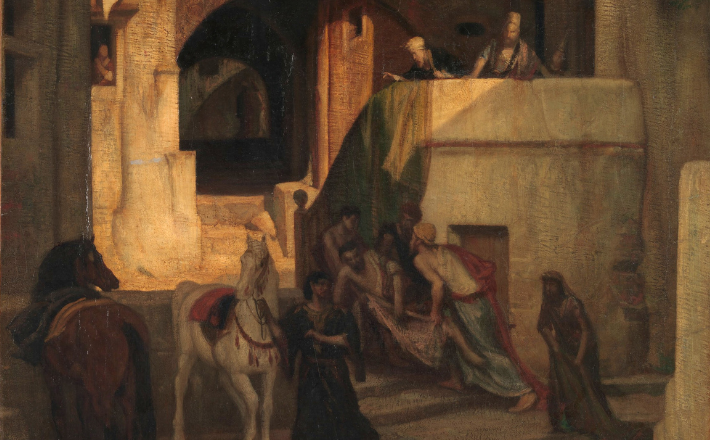Commentary on Psalm 25:1-10
Psalm 25 is an alphabetic acrostic poem.1 Though its structure is obvious in Hebrew, it is obscure in translation.
But when we attend to the structure of Psalm 25 we can start to comprehend its message. In short, the psalm claims that God shows us the way. God provides the way out of danger, the way to live in harmony with others, the way to order our lives. And this psalm shows us the way to pray.
The structure of the psalm
Psalm 25 is one of several alphabetic acrostics in the Psalter (Psalms 9-10, 34, 37, 111, 112, 119, 145). As such, each line begins with a successive letter of the Hebrew alphabet, with the 22 verses of the psalm corresponding to the 22 Hebrew letters. The chart below contains the initial words of the first three lines of poetry to illustrate the pattern.
| English | Hebrew | Letter of the Hebrew Alphabet |
| To you, O LORD (verse 1) | ’eleka YHWH | ’aleph |
| In you I trust (verse 2) | beka vatakhti | bet |
| Indeed, all who wait on you (verse 3) | gam kol-qoveka | gimel |
The alphabet is the fundamental element of one’s education. It is the first thing that any young student learns on the pathway to literacy. In ancient Israel, writing was seen as the special medium of God’s revelation. Thus the alphabet became associated with God’s word. Since the Torah, God’s law or instruction, came to Israel through writing, the structure of the alphabet was understood to reflect the structure that God provides the community through the law.
Many of the alphabetic acrostic psalms revolve around the theme of the law or instruction. Psalm 119 is the prime example. At 176 verses, it is an extended meditation on the law of God. In this case, the poem contains 22 eight-line stanzas, the first word of each line starting with the same Hebrew letter. The theme that unites all of these verses is the instructive value of God’s word, epitomized in its most famous verse: “Your word is a lamp unto my feet and a light unto my path” (verse 105).
Walking and learning
Psalm 119:115 suggests that the psalmist is walking, going along a way and in need of instruction and guidance. The word of God, the law, illuminates the path. Psalm 25 has the same message and a similar structure. It makes frequent use of words related to teaching, learning, walking, and being led along pathways.
In Psalm 25, the psalmist asks God to show him God’s ways, to make them understandable (verse 4), and then to lead him in those ways (verse 5). The Hebrew verb at the beginning of verse 5 means literally “cause me to walk” (hadrikheni). God is the one who reveals the path, and God is the one who makes the psalmist walk it.
Everyone benefits from God’s instruction, both the humble (verse 9) and sinners (verse 8). Sinners can learn the right way by attending to God’s word. The psalmist should know; he himself is a sinner (verse 7). He has failed to walk uprightly in the past, but hopes that God will instruct him and keep him on the right track as he goes forward (see verses 11, 18).
Teaching one how to pray
The poem’s structure enables one to memorize it easily, at least in Hebrew. The acrostic guides the one reciting it from one line to the next. Similarly, the psalm contains a series of “hinge words” that facilitate memorization. Hinge words are words that appear in one line and are then repeated in the next, often in slightly different but related form.
In verses 2-3, for example, we find two forms of the Hebrew verb bosh, “to be ashamed”: ’evoshah (“do not let me be put to shame,” verse 2) and yevoshu (“let them be put to shame,” appearing twice in verse 3). In verses 4-5 two words about walking occur that are drawn from the root drk: derakheka (“your ways,” verse 4) and hadrikheni (“cause me to walk,” verse 5). In the same two verses, the imperative form of the verb “to teach” is repeated: lammedeni (“teach me,” verses 4-5). And in verses 6-7 the verb zkr, “to remember,” appears three times: zekhor (“remember [your compassion],” verse 6) and al-tizkor … zikhor-li-attah (“do not remember [the sins] … remember me,” verse 7).
There are other examples across the psalm, but these alone, and especially the verbs of memory, highlight the fact that this psalm has been carefully arranged so that it can be memorized. The acrostic form and the hinge words enable one to commit these words to memory. And once memorized, the psalm provides a roadmap for the faithful to pray. The psalm, like God’s law, becomes a guide. It travels with you whenever you go. The psalm thus becomes a way for God’s order to be realized in one’s life through prayer.
The instruction of Psalm 25
The psalm begins like a classic lament (see, for example, Psalm 6), with a statement of trust and a series of direct requests for God’s aid. The psalmist is in trouble. And when trouble besets him, he thinks about the law of God. The psalmist is keenly aware of the ways that he has failed to keep the law. Indeed, the specter of shame, guilt, and sin hangs over the psalmist (verses 2-3, 7-8). Even so, the psalmist understands that salvation comes in the form of divine instruction: “Teach me, for you are the God of my salvation” (verse 5). The psalmist imagines his salvation in the form of learning.
So what can we learn about God from Psalm 25? The psalmist articulates a set of characteristics about God. These characteristics are revealed explicitly through his direct claims about the divine character (verse 8-10) and implicitly through his requests for God’s action (verses 1-7). God provides order and meaning for human life through the law (verses 4-5). God forgives (verses 7-8). God acts on behalf of the faithful, satisfying those who wait on God (verses 3, 5). God is in it for the long haul; that is, God has been faithful in the past, and God will continue to be faithful in the future (verses 6, 8-10).
And what can we learn about the psalmist and, by extension, about ourselves? The psalm reveals much about what it means to walk the path of life in a relationship with God. Being a sinner doesn’t exclude us from the ability to learn from God (verse 7). Even those who have experienced great shame and oppression can experience God’s redemption (verse 2). God’s mercy overwhelms any of our failings (verses 8-9). Following God’s paths leads us to salvation (verses 1-2, 5, 10).
Psalm 25 shows us these paths of salvation. It shows us the way.
Notes
- Commentary previously published on this website for July 14, 2019.


July 13, 2025